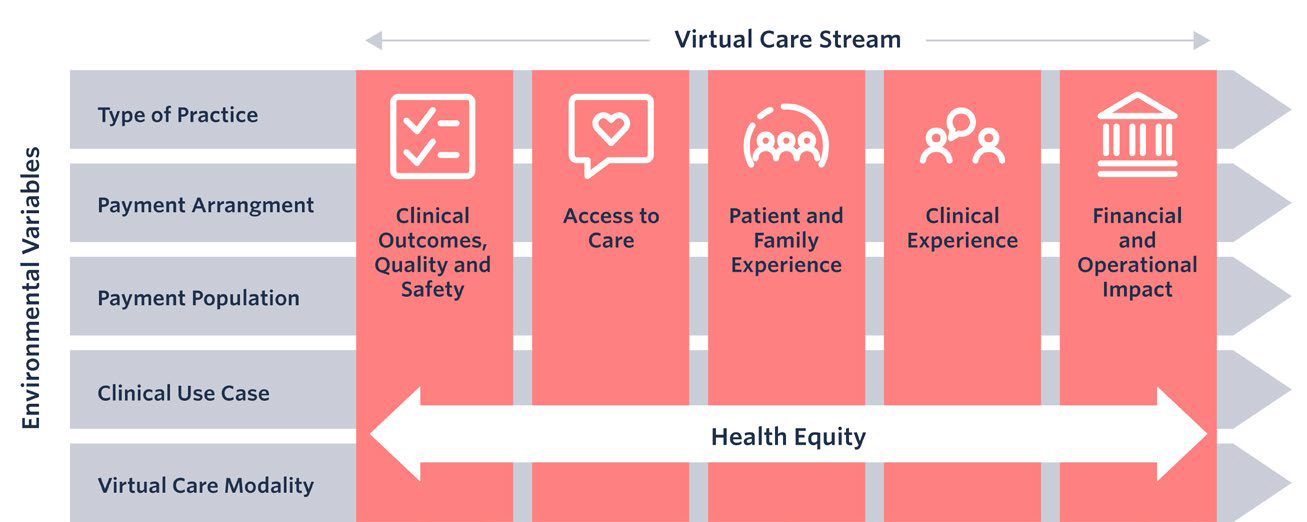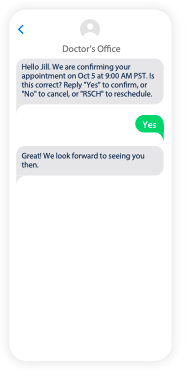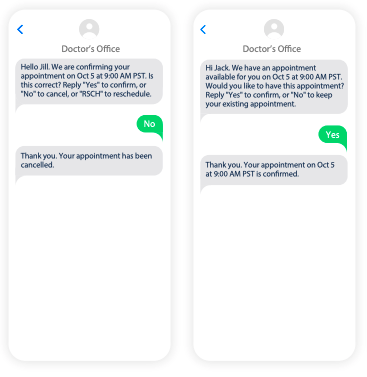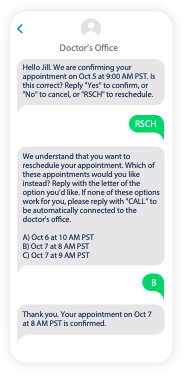Creating the
Future of Hybrid
Healthcare
CONTENTS
Contents
- Introduction
- Healthcare delivery from anywhere
- Automated, omnichannel appointment management
- Moving forward with telehealth
- Continiung care from home
- A person-centered engagement platform built for hybrid care
INTRODUCTION
Introduction
The future of healthcare delivery is quickly taking shape from adaptations to the pandemic. Telehealth is offering a new level of convenience that is here to stay. Research from Deloitte shows that approximately 25% of clinician visits moving forward will be virtual. For healthcare organizations to embrace hybrid care delivery, they’ll need to be sure they have the right communications infrastructure to support it.
As part of meeting consumers where they are, clinicians can leverage technology to build long-term strategy and workflows around hybrid use-cases. Though there are unknowns around payment parity for telehealth and the post-COVID regulatory environment, there are critical steps clinicians can take now to minimize data silos and integrate patient engagement channels at scale.
While evidence of virtual care’s value has grown substantially in recent years, it is often focused on direct reimbursement, program costs and short-term clinical benefit measures for “parallel care.” The future of hybrid health requires a broader and more holistic framework to measure the value of virtual care and capture it to better serve patients.
The American Medical Association, in collaboration with Manatt Health, developed a “Return on Health" ; framework to articulate the value of digitally enabled care that accounts for the impact on patients, clinicians, payors, and society.
RETURN ON HEALTH FRAMEWORK
Return on Health Framework

Key areas of opportunity health organizations can leverage today to realize a hybrid care model include:
- Increasing access to care through integrated virtual visits: enhanced capabilities in supporting virtual visits like caregiver support, interpreters, EHR integration, virtual waiting room
- Closing care gaps through coordinated appointment management: scheduling and triaging patients for both in-person and virtual visits
- Scaling your teams and extending care through remote monitoring: care plan adherence, patient education, medication adherence
In this ebook, we’ll share best practices across these use-cases that characterize the future of healthcare delivery, and examples of organizations leveraging a platform approach to help scale with their evolving needs.
HEALTHCARE DELIVERY FROM ANYWHERE
Healthcare Delivery From Anywhere
For decades, the promise of virtual health fueled investment for creating a more convenient, cost-effective, and high-quality healthcare system. The urgency to innovate in response to the pandemic accelerated implementation, adoption, and utilization of telehealth solutions across care settings, provider types, and patient demographics. This acceleration was further supported by US regulatory changes from the Centers for Medicare & Medicaid Services (CMS), among other government bodies, and commercial payers that temporarily removed barriers to adoption.
There is an immediate opportunity to improve the patient experience and reduce the total cost of care by transforming how patients access and navigate it. While traditional, in-person care delivery has its place, historically, it’s often overused relative to the severity and specific needs of patients, and can unnecessarily delay access to care by days or even weeks for certain services.
Leveraging a hybrid of virtual / in-person and real-time / asynchronous care modalities improves convenience, timely access, and patient satisfaction.

Automated, Omnichannel Appointment Management
One of the most critical elements of delivering high-quality healthcare is an efficient scheduling and appointment management process that includes patients confirming, canceling or rescheduling in-person and virtual appointments, in addition to standard reminder messages. After care delivery, provider finding and patient scheduling are the two characteristics of a hospital or health system that matter most to healthcare consumers, according to research from Accenture. Long hold times, high no-show rates, and the inability to easily schedule, confirm, adjust, and cancel appointments creates a bad patient experience and lost revenue for health organizations.
Healthcare providers spent $342.4 million on scheduling in 2020, and are anticipated to increase their investment to as much as $690 million by 2027. Adapting to the new normal of hybrid care models means not only leveraging the communication channels your patients already use everyday but also leveraging a platform that will help scale with your health organization’s evolving needs. Multi-channel appointment management has proven to increase patient satisfaction and cost-savings.
Reaching patients on the right communication channels is fundamental to creating a patientcentric appointment management experience that includes ensuring adherence to pre-visit requirements, such as fasting.
Provide Options
Give patients the ability to tell you how to best reach them for all varieties of messages. Some may prefer to receive appointment confirmations via email, while others are more likely to see a text on their phone. Alternatively, voice calls are best for those who are visually impaired or without a mobile phone. Equally as important is knowing how to escalate communication. If a response is not received within a particular period of time, then you should be able to trigger the next preferred channel. Taking all potential preferences into account helps increase delivery and open rates of your messages to reduce no-shows and last minute cancellations.
Send appointment reminders that allow rescheduling
Not surprisingly, automated appointment reminders reduce no-shows, but it’s even more helpful if those communications allow for patients to respond back in case they need to reschedule. You can eliminate manual administrative work by having your scheduling system integrated with your patient communications platform.
Here’s three scenarios of bidirectional appointment reminders sent to a patient via SMS:

Patient responds back with "Yes" to confirm
- Send back an SMS to the patient with a confirmation
- Update EHR with the confirmation of this appointment

Patient responds back with "No" to cancel
- Send a cancellation confirmation to the patient
- Update EHR that the appointment is cancelled
- Find the patient that is on the waiting list for this physician and send SMS to see if they want to take this earlier appointment slot that just opened up

Patient responds back with "RSCH" to reschedule
- Pull the next available appointments from your EHR
- Send these options to the patient to select one of them or provide an option to automatically connect with their doctor’s office “CALL”
- Update EHR if patient chooses one of the provided dates

Moving Forward With Telehealth
Virtual care delivery will be essential to alleviating access inequities across the country, as well as ensuring the economic viability of our health system. There are four major considerations in establishing virtual health as a permanent fixture of our healthcare delivery system.
Payer-provider contract reform: already we are seeing evolving provider-payer contracting that allows for an expansion of telehealth. Accordingly, clinicians can shift their operating models as they relate to staffing, technology adoption, and real estate footprint. Virtual health organizations will benefit from new reimbursement models that require the provider to digitally diagnose and, when applicable, virtually treat the patient before authorizing in-person visits.
Remote services: patients looking to avoid the risk and long wait times at clinics and hospitals will increasingly seek to receive their lab work, tests, and treatments at less costly, community-based sites. Subsequently, there’ll be an increased demand for at-home exam kits, lab tests, and digital diagnostic tools.
Mandatory HIPAA compliant capabilities: security, scalability, and feature functionality are all important technological factors to remain competitive, adhere to industry regulations, and minimize barriers to entry.
EHR integration and interoperability: telehealth platforms, asynchronous care delivery solutions, and virtual health tools need to integrate with the EHR system. Interoperability is crucial to optimize care coordination, quality, and the patient experience.
See how two healthcare organizations are customizing and personalizing telehealth solutions for patients:
Omnichannel telehealth


Telemedicine provider MDLive conducts virtual visits with board-certified physicians and licensed therapists anytime and from anywhere. It needed a secure communication platform that could scale as they grew 30-40% YOY. To continue providing patients with fast and convenient access to care, MDLive first integrated Twilio’s Programmable Voice APIs. Soon after, they added Twilio’s Video and Messaging APIs into their homebuilt platform to enable faster and easier communication with patients.
For example, a patient requesting a 2 AM consultation in a rural area may not find a provider nearby. But based on the state in which the patient is located, the messaging solution within MDLive sends an alert to an available provider who is fully licensed to practice medicine in that patient’s state and can meet with the patient on a video conference. Using Twilio, MDLive’s video consultation success rate increased by16% and all together their NPS has improved by +70 points.
Ensuring patient safety
with virtual check-in


At the onset of the pandemic, patient engagement application Philips Patient Management (formerly Medumo) wanted to develop a system for patients to virtually check in using the digital technologies that they already use on a daily basis.
Using Twilio Studio, Phillips was able to quickly and easily build their communication workflows in just six weeks. The resulting virtual check-in system allows clinicians to personalize the content of their messages based on patient data, the type of medical visit or procedure, channel, and language. From day-before procedure reminders to day-of check-in protocols, patients have a line of communication with their doctor and receive guidance about their care plan along the way via Twilio’s Programmable Messaging API.
Continuing Care From Home
Remote patient monitoring leverages digital technologies to monitor and capture patients’ health data and subsequently transmits this information to healthcare providers for assessment, or at times, treatment recommendation. Enabling patients to manage their health from home scales delivery of care, but to be effective remote monitoring needs the right communications infrastructure that can support multichannel engagement and ensure deliverability.
Here are three common use cases with customers that use Twilio:
Medical outreach campaigns


Patient engagement platform CareMessage focuses on serving underserved populations, among whom more than 25% have landlines, while only 21% have both a landline and cell phone. Most care management platforms do not give their clients visibility into message deliverability statistics or response rates, which are critical to measuring the success of medical outreach campaigns. CareMessage is different.
When CareMessage clients import numbers, they’re automatically sorted via Twilio LookUp to determine which number is a landline and which number is a mobile device. This allows CareMessage clients to avoid paying for texts that will never be delivered to a landline, and enables them to pivot to a cell phone. CareMessage also uses a Twilio-powered fallback to automatically call patients who do not respond to text messages. Leveraging Twilio’s Programmable Voice and Messaging APIs on the CareMessage platform drastically increases response rates for its clients, provides insight into message deliverability, and scales. Within 12 months, CareMessage sent nearly 1.5 million SMS messages.
Flexible patient communication

Patient communications startup WELL Health aims to eliminate the friction that often keeps patients from good clinical outcomes and better relationships with their providers. Because nearly every interaction they manage with patients is unique, WELL Health needed real-time data integration, customizable message content and routing logic, and intelligent automated interactions, all purposebuilt to support over 100 healthcare use cases.
WELL Health leverages Twilio’s Programmable Messaging, Email (Twilio SendGrid), and Voice APIs to enable health systems and hospitals to use two-way multilingual communication in a patient’s preferred channel, without making them download an app or log in to a portal.
The partnership with Twilio enables providers to evaluate two HIPAA-compliant options for patient messaging through a single partner, eliminating the time and resources it takes to assess multiple vendors and making it easier to quickly deploy digital communications.
Option 1: build a patient engagement platform on top of Twilio’s SMS and voice delivery application programming interfaces.
Option 2: leverage a prebuilt patient engagement platform by Well Health that offers multilingual messaging in 19 languages and can include texting, email, telephone and live chat.
A model for increasing patient compliance


A single SMS message per day can increase patient compliance, whether the aim is to help someone lose weight, stop smoking, or consistently take their medications, according to multiple studies. Mobile health is the new frontier for medical research and SMS shows great promise for improving public health initiatives.
Over the last decade, the Center for Wireless and Population Health Systems (CWPHS), a research organization at the University of California, San Diego (UCSD), has studied how two-way text interactions can be used to promote health and prevent disease and disability. CWPHS has conducted 16 SMS studies. It has sent over 889,000 text messages to nearly 1,800 study participants, and received over 238,000 responses.
The CWPHS messaging engine enables highly personalized interactions with users in multiple languages, across all providers and devices. In less than 48 hours, CWPHS connected the Twilio Messaging API, providing the ability to send and receive messages.
CWPHS can build all SMS projects on the same core engine and customize the rules and messages displayed for each new application. It also can create a full decision tree on Twilio — based on how the patient responds, the built-in logic allows the system to reply with additional questions, make recommendations, and reach out to doctors, case managers, or in some cases, even escalate it to emergency personnel. All of this supports its goal to make the patients feel as if they are communicating with a live health coach, and not a robot.
With Twilio, CWPHS has seen an increase in reliability with increased message deliverability compared to any other system it has used — at less than $0.05 per day per participant.
A Person-Centered Engagement Platform Built For Hybrid Care

Improving patient outcomes involves more than practicing great medicine. It also requires appropriate, timely and frictionless patient communication. Health organizations today are already supporting key areas of virtual health, and will only continue to see a rise in demand. To provide patient-centric care delivery, you need a flexible platform that can help you meet the needs of today and tomorrow, and easily embed into regular clinical workflows and operations.
Twilio provides the necessary capabilities to customize patient communications while streamlining and standardizing engagement across every part of the patient journey. Rather than manage many disparate vendor communication configurations with sub-optimal patient outcomes, clinicians can leverage Twilio’s patient engagement platform to configure communication workflows across appointment management, virtual visits, and remote patient monitoring all in one place.
The future of healthcare will increasingly depend on APIbased platforms like Twilio that provide flexibility, scale, and extensibility throughout care delivery modalities.
Want to learn more?